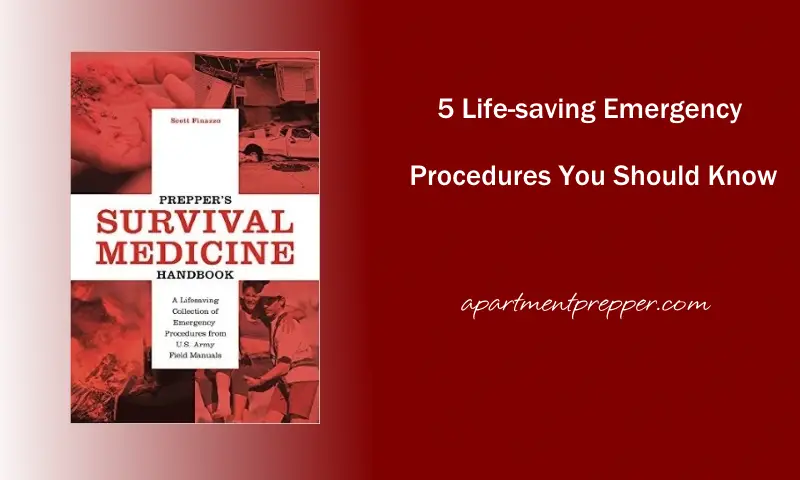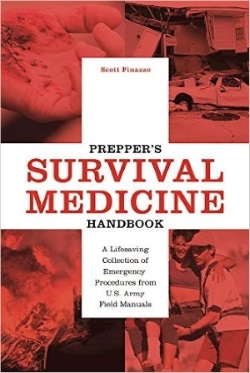Today we are featuring a new book by Scott Finazzo, Prepper’s Survival Medicine Handbook: A Lifesaving Collection of Emergency Procedures from U.S. Army Field Manuals. The book is designed to help you in an emergency when no doctor is available. It covers various types of health emergencies and what you have to do to survive. Each condition includes symptoms to help you identify what you are facing, prevention, as well as treatment.
About the Author
Scott Finazzo is an emergency responder, having worked as a professional firefighter for nearly twenty years. Scott has been an instructor for firefighting tactics, confined space rescue, first aid, CPR, Community Emergency Response Teams, and other emergency training. He is the author of several books: Prepper’s Workbook Prepper’s Guide to Knotts and Neighborhood Emergency Response among others.
Recently I had the opportunity to ask Scott the following:
What five emergency procedures should the average person learn to perform?
Here was his response:
You can never be too prepared for medical emergencies because if Murphy has his way, and he always does, you will certainly encounter a situation in which you aren’t ready. But, if I had to list 5 medical procedures that you should know in every situation they are:
Carries and Drags
Moving an injured person who cannot ambulate on their own can be extremely cumbersome, but moving someone who is unconscious is more difficult than most people realize. In any type of situation, whether it is an injury in a remote location, a mass casualty event, or if there is a need to relocate someone out of harm’s way, knowing good techniques can be be the difference between success and additional injuries to the rescuer(s). My book outlines a variety of carries and drags that utilize one, two, or more people that will enable you to move a victim to safe place. This is a skill that should be considered and practice ahead of time because to just “toughen up” and move someone is not practical, safe, or in some cases, even possible.
CPR
CPR is a buyer of time. Unfortunately if you are out in the wilderness or a long way from advanced medical care, statistics show that CPR alone won’t be the dramatic life saving event that the movies portray. I’ve been in the emergency medical field for a long time and can say that even in the best of circumstances, a lot of things have to go right, to return a pulse and respiratory drive to someone. Having said that, statistics also show that if someone’s heart stops beating and CPR begins immediately, the chances of survival increase dramatically. So whether you are preparing for a doomsday scenario or want to be a helpful citizen in everyday life, learning and performing CPR can be that critical link to keep someone alive until advanced medical care can be received.
Bleeding Control
This has practical uses every day. First and foremost, again, utilize PPE. The interesting thing about bleeding control, is for the majority of cuts or wounds, we instinctively do the right thing: direct pressure and elevation. In most instances, providing direct pressure on a wound and elevating it above the heart will control the bleeding. Leave the dressing on (depending on which source you’re reading) for a minimum of 15 minutes before rechecking the wound. The next steps, for more serious bleeding, involve slowing the bleeding process by identifying and applying force to pressure points. The final step, which you should obtain adequate training before attempting, is a tourniquet, which should restrict almost all blood flow to an extremity.
Medical Emergency Recognition
Oftentimes there is not a lot that can be done about medical emergencies such as heart attack, stroke, seizure, etc. in the field, but early recognition of them can be critical. Knowing the signs and symptoms of a heart attack, stroke, seizure, diabetic emergency, shock, allergic reaction, and situations like that allows you to treat the few things you can, and most importantly to recognize that the patient needs advanced medical care as soon as possible.
Personal Protective Equipment “PPE”
While not a “procedure”, one thing you must always have available to you is personal protective equipment (PPE). The means to protect yourself is not selfish, it is understanding that you will want to be able to do the greatest good for the greatest number of people. You serve no one by being part of the problem and becoming a victim yourself. In most medical scenarios it means gloves (often made of nitrile as latex is falling out of favor due to common allergies to it). Safety glasses are also a good idea. Your eyes provide a direct route into your bloodstream, as does your mouth, so consider keeping a surgical mask or two in your kit/bag/car/etc. Other things to consider are hearing protection, work gloves, sturdy footwear, a medical gown, and weather appropriate clothing.
Prepper’s Survival Medicine Handbook is a great reference to have in the event of a life threatening emergency. It is great book for your preparedness library, or as an addition for your first aid kit. Pick one up for yourself, along with a few other copies to give as gifts.
© Apartment Prepper 2016
Disclosure: This is a professional review site that sometimes receives free merchandise from the companies whose products we review and recommend. We are independently owned and the opinions expressed here are our own. Apartmentprepper.com is a participant in the Amazon Services LLC Associates Program, an affiliate advertising program designed to provide a means for sites to earn advertising fees by advertising and linking to Amazon.com



This is my favorite resource to learn about First Aid: https://www.firstaidforfree.com/